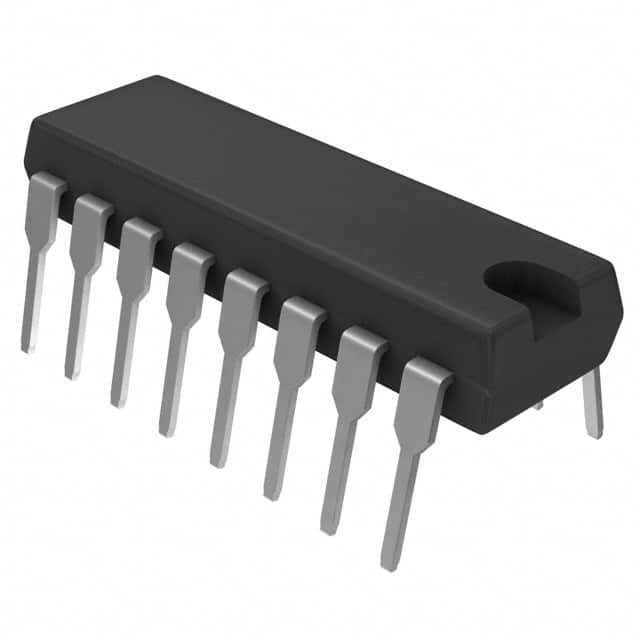Xem thông số kỹ thuật để biết chi tiết sản phẩm.

SN74LS169BN
Product Overview
- Category: Integrated Circuit (IC)
- Use: Counter/Shift Register
- Characteristics: High-speed, synchronous, 4-bit binary counter/shift register
- Package: DIP (Dual In-line Package)
- Essence: The SN74LS169BN is a versatile IC that can function as both a counter and a shift register. It offers high-speed operation and synchronous counting/shift capabilities.
- Packaging/Quantity: The SN74LS169BN is typically sold in packs of 25 units.
Specifications
- Supply Voltage: 4.75V to 5.25V
- Operating Temperature Range: -40°C to +85°C
- Maximum Clock Frequency: 55 MHz
- Number of Bits: 4
- Logic Family: LS-TTL (Low-power Schottky Transistor-Transistor Logic)
Detailed Pin Configuration
The SN74LS169BN has a total of 16 pins, each serving a specific purpose. Here is the detailed pin configuration:
- CP (Clock Pulse) - Input
- P0 (Parallel Data Input) - Input
- P1 (Parallel Data Input) - Input
- P2 (Parallel Data Input) - Input
- P3 (Parallel Data Input) - Input
- GND (Ground) - Ground
- Q0 (Serial Output) - Output
- Q1 (Serial Output) - Output
- Q2 (Serial Output) - Output
- Q3 (Serial Output) - Output
- MR (Master Reset) - Input
- PE (Parallel Enable) - Input
- TE (Terminal Count Enable) - Input
- TC (Terminal Count) - Output
- VCC (Supply Voltage) - Power
- CE (Clock Enable) - Input
Functional Features
- Counter Mode: In this mode, the SN74LS169BN acts as a 4-bit binary counter. The parallel data inputs (P0-P3) are used to set the initial count value, and the clock pulse (CP) increments the count on each rising edge.
- Shift Register Mode: In this mode, the IC functions as a 4-bit shift register. The parallel data inputs (P0-P3) are serially shifted out through the serial outputs (Q0-Q3) upon each clock pulse.
- Reset and Enable: The master reset (MR) input allows resetting the counter/shift register to its initial state. The clock enable (CE) and parallel enable (PE) inputs control the clocking and parallel loading operations, respectively.
- Terminal Count: The terminal count (TC) output goes high when the counter reaches its maximum count value, providing a signal for external circuitry.
Advantages and Disadvantages
Advantages: - High-speed operation - Versatile functionality as both a counter and a shift register - Synchronous counting/shift capabilities - LS-TTL logic family provides low-power consumption
Disadvantages: - Limited to 4-bit counting/shift operations - Requires external circuitry for more complex applications
Working Principles
The SN74LS169BN operates based on synchronous counting and shifting principles. In counter mode, the parallel data inputs set the initial count value, and the clock pulse increments the count on each rising edge. In shift register mode, the parallel data inputs are serially shifted out through the serial outputs upon each clock pulse. The master reset input allows resetting the counter/shift register to its initial state, while the clock enable and parallel enable inputs control the clocking and parallel loading operations, respectively.
Detailed Application Field Plans
The SN74LS169BN finds applications in various fields, including: - Digital counters - Serial-to-parallel data conversion - Data storage and retrieval systems - Frequency division circuits - Industrial automation - Communication systems
Detailed and Complete Alternative Models
Some alternative models to the SN74LS169BN that offer similar functionality include: - CD40161B: 4-bit synchronous binary counter/shift register - MC74HC595: 8-bit serial-in, serial or parallel-out shift register - 74HC191: 4-bit synchronous up/down binary counter
These alternative models can be considered based on specific requirements and compatibility with existing circuitry.
Word count: 470 words
Liệt kê 10 câu hỏi và câu trả lời thường gặp liên quan đến ứng dụng SN74LS169BN trong giải pháp kỹ thuật
Sure! Here are 10 common questions and answers related to the application of SN74LS169BN:
Q: What is SN74LS169BN? A: SN74LS169BN is a 4-bit synchronous up/down counter IC (integrated circuit) commonly used in digital electronics.
Q: What is the operating voltage range for SN74LS169BN? A: The operating voltage range for SN74LS169BN is typically between 4.75V and 5.25V.
Q: How many inputs does SN74LS169BN have? A: SN74LS169BN has four data inputs (D0-D3), two control inputs (CLK and UP/DN), and an asynchronous clear input (CLR).
Q: What is the maximum clock frequency for SN74LS169BN? A: The maximum clock frequency for SN74LS169BN is typically around 25 MHz.
Q: Can SN74LS169BN be used as a binary counter? A: Yes, SN74LS169BN can be used as a binary counter by connecting the UP/DN input to a fixed logic level.
Q: How do I connect SN74LS169BN in an up-counting mode? A: To use SN74LS169BN in an up-counting mode, connect the UP/DN input to logic high (VCC) and provide clock pulses to the CLK input.
Q: How do I connect SN74LS169BN in a down-counting mode? A: To use SN74LS169BN in a down-counting mode, connect the UP/DN input to logic low (GND) and provide clock pulses to the CLK input.
Q: Can SN74LS169BN be cascaded to create larger counters? A: Yes, SN74LS169BN can be cascaded with other counters to create larger counter configurations.
Q: What is the maximum count value of SN74LS169BN? A: The maximum count value of SN74LS169BN is 15 (1111 in binary).
Q: Can SN74LS169BN be used in synchronous applications? A: Yes, SN74LS169BN is designed for synchronous operation and can be used in synchronous applications where precise timing is required.
Please note that these answers are general and may vary depending on specific application requirements and datasheet specifications.

